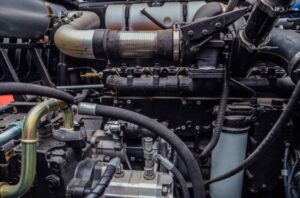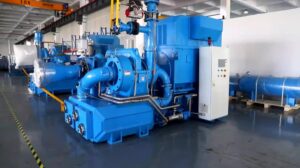Does 4 Stroke Engine Need Oil?
Do 4 stroke engines need oil?
Yes, a four-stroke engine oil requires oil for lubrication. Unlike 2-stroke engines, the oil in a 4-stroke engine isn’t mixed with the fuel. Instead, it is housed in a separate compartment, the crankcase. The primary role of oil in a 4-stroke engine is to lubricate the moving parts, reducing friction and wear. This helps to maintain efficient engine performance and prolongs its lifespan. The oil also serves as a coolant, helps to seal piston rings, and cleans the engine by removing debris and contaminants.
How is a 2 Stroke Engine Lubricated?
In 2-stroke engines, lubrication is achieved by mixing oil with the fuel. As the fuel-oil mixture burns, the oil provides necessary lubrication to the moving parts, such as the crankshaft bearings and cylinder wall. This method allows for a simpler engine design but requires precise oil-to-fuel ratios to avoid engine damage or excessive smoke.
How 2 Stroke Engines Work?
A 2-stroke engine completes a power cycle with two strokes of the piston during only one crankshaft revolution. This is achieved through the use of ports or valves that control the entry and exit of gases into and out of the combustion chamber. During the compression stroke, the air-fuel mixture is compressed and ignited, while the exhaust gases are expelled during the expansion stroke. This design allows 2-stroke engines to have a higher power output compared to 4-stroke engines of the same size but at the cost of higher emissions and less fuel efficiency.
What is 4 stroke oil
4-stroke oil, also known as 4-cycle oil, is a specialized lubricant designed for 4-stroke engines, which are commonly used in cars, motorcycles, lawnmowers, and other machinery. Unlike 2-stroke engines, 4-stroke engines have a separate oil reservoir, so the oil is not mixed with fuel.
How is a 4 Stroke Engine Lubricated?
Oil for a 4 stroke engine in a four stroke motor oil is more complex than in a 2-stroke engine. Oil is stored in a sump and is circulated by a pump. It is distributed throughout the engine, lubricating essential components such as the crankshaft bearings, connecting rods, and camshaft. The oil forms a film that reduces wear and friction, helping to keep the engine running smoothly over time.
How 4 Stroke Engines Work?
A 4-stroke engine operates on four distinct strokes: intake, compression, power, and exhaust. During the intake stroke, the intake valve opens to allow the air-fuel mixture into the combustion chamber. This is followed by the compression stroke where the mixture is compressed. The power stroke occurs next, where the compressed mixture is ignited, generating power. Finally, the exhaust stroke expels the combustion gases. This cycle is repeated, and the precise control over valve timing improves the engine’s efficiency and reduces emissions.
What's the Difference Between a 2 Stroke and 4 Stroke Engine?
The primary difference between 2-stroke Engine oil and 4-stroke Engine Oil engines is the number of strokes the piston makes to complete a power cycle. A 2-stroke engine completes the cycle in two strokes, making it simpler and capable of producing more power per revolution. However, it is less fuel-efficient and emits more pollution. On the other hand, a 4-stroke engine uses four strokes to complete a cycle, leading to better fuel efficiency and lower emissions but with a more complex design.
Do 4 Stroke Engines Require Engine Oil in the Fuel?
No, 4-stroke engines do not require oil to be mixed with the fuel. They have a separate lubrication system where oil is circulated within the engine to lubricate moving parts. This system allows for better control of oil distribution and reduces the risk of combustion chamber contamination, which can occur in 2-stroke engines where oil is mixed with fuel.
The Design of 2 Stroke Outboard is Less Complex Than a 4 Stroke Engine, This is Because
The design of a 2-stroke outboard engine is inherently simpler than that of a oil 4 stroke engine. This simplicity stems from the fact that 2-stroke engines do not have valves for controlling air and exhaust flows. Instead, these functions are managed by the movement of the piston covering and uncovering ports in the cylinder wall. This results in fewer moving parts and a lighter, more compact engine. However, this simplicity also leads to increased noise, higher emissions, and less fuel efficiency compared to 4-stroke engines.
A 4 Stroke Outboard is Far More Fuel Efficient Than a 2 Stroke. Being More Fuel Efficient Means
A 4-stroke outboard engine is significantly more fuel-efficient than a 2-stroke engine due to its precise control over fuel intake and exhaust timing, which minimizes wastage. Being more fuel-efficient means that the engine consumes less fuel for the same amount of power output, resulting in lower operating costs and less environmental impact. Additionally, the improved efficiency contributes to a reduction in the total volume of emissions, helping to meet stricter environmental regulations.
Which Engine is Best: 2 Stroke or 4 stroke engine oil?
Choosing between a 2-stroke and a 4-stroke engine depends on the specific needs and applications. 2-stroke engines are preferred for their higher power output and simplicity in design, making them ideal for lightweight, high-speed applications like dirt bikes and small watercraft. However, for applications requiring greater fuel efficiency, reduced emissions, and longer engine life, such as in cars and larger boats, 4-stroke fuel are generally better. The choice also hinges on the operational costs and environmental considerations of the user.
Best fuel additive for 4 stroke outboard
The best fuel additive for a 4-stroke outboard motor depends on your specific needs, such as improving performance, cleaning the fuel system, stabilizing fuel, or preventing corrosion. Here are some highly recommended options:
1. Sta-Bil Marine Fuel Stabilizer
Purpose: Prevents fuel degradation and ethanol-related issues.
Benefits: Protects against corrosion, stabilizes fuel for long-term storage, and improves engine performance.
Best For: Boats that sit idle for extended periods.
2. Sea Foam Motor Treatment
Purpose: Cleans fuel injectors, carburetors, and combustion chambers.
Benefits: Removes carbon deposits, lubricates upper cylinders, and stabilizes fuel.
Best For: Routine maintenance and cleaning.
3. Star Tron Enzyme Fuel Treatment
Purpose: Combats ethanol problems and improves fuel efficiency.
Benefits: Prevents phase separation, enhances combustion, and reduces emissions.
Best For: Boats using ethanol-blended fuels.
4. Ring Free Fuel Additive by Yamaha
Purpose: Prevents carbon buildup in the combustion chamber.
Benefits: Keeps pistons, rings, and valves clean, improving performance and longevity.
Best For: Yamaha outboards (but works well with other brands too).
5. Quicksilver Fuel System Cleaner & Stabilizer
Purpose: Cleans fuel systems and stabilizes fuel.
Benefits: Removes deposits, prevents corrosion, and improves fuel efficiency.
Best For: Mercury outboards and other 4-stroke engines.
6. ValvTect Marine Gasoline Additive
Purpose: Protects against ethanol and moisture issues.
Benefits: Prevents corrosion, phase separation, and fuel system clogs.
Best For: Boats in humid or marine environments.
Tips for Choosing:
Ethanol Protection: If you use ethanol-blended fuel, choose an additive that combats ethanol-related issues.
Cleaning Needs: For engines with carbon buildup, opt for a cleaner like Sea Foam or Ring Free.
Storage: If storing your boat, use a stabilizer like Sta-Bil or Quicksilver.
Manufacturer Recommendations: Always check your outboard manufacturer’s guidelines for compatible additives.
Using the right fuel additive can enhance performance, extend engine life, and save on costly repairs.
Two and Four Cycle Engine Oil
Two and oil in 4 stroke engine are formulated differently to meet the lubrication needs of their respective engine types. Two-cycle oil is lighter and designed to mix with fuel, burning in conjunction with the fuel-air mixture to provide lubrication. It often contains additives that help reduce smoke and prevent engine deposits. In contrast, four-cycle oil is similar to conventional motor oil and is thicker, designed to withstand higher temperatures and pressures without burning away, providing a durable lubrication layer within the engine’s moving parts.
Final Thoughts
When deciding between a 2-stroke and a 4-stroke engine, consider the specific requirements of your application. Each engine type has its advantages and trade-offs in terms of complexity, efficiency, and environmental impact. Proper understanding and maintenance of the engine’s lubrication system are crucial for optimal performance and longevity. Whether choosing two-cycle or four-cycle oil, always use the type recommended by the engine manufacturer to ensure proper engine function and avoid potential damage.
FAQs
4-cycle oil, also known as 4-stroke oil, is a lubricant specifically designed for 4-stroke engines, commonly found in cars, motorcycles, lawnmowers, and other machinery. Unlike 2-cycle oil, it is not mixed with fuel but is instead added to a separate oil reservoir. It lubricates engine components, reduces friction, and helps maintain engine performance and longevity.
Yes, a 4-stroke engine requires oil for proper operation. The oil is stored in a separate reservoir and circulates through the engine to lubricate moving parts, reduce friction, prevent overheating, and minimize wear and tear. Unlike 2-stroke engines, 4-stroke engines do not mix oil with fuel, so regular oil checks and changes are essential to maintain engine performance and longevity.
No, a 4-stroke engine does not require oil to be mixed with the fuel. Unlike 2-stroke engines, which rely on an oil-fuel mixture for lubrication, 4-stroke engines have a separate oil reservoir that lubricates the engine’s internal components. Adding oil to the fuel in a 4-stroke engine can cause poor performance, excessive smoke, and potential damage. Always use clean fuel and ensure the engine’s oil level is maintained separately.
A 2-stroke engine completes a power cycle in two strokes of the piston (one crankshaft revolution), while a 4-stroke engine completes it in four strokes (two revolutions).
No, 4-stroke engines do not require oil to be mixed with the fuel. They have a separate lubrication system.
2-stroke engines fire once every revolution (power stroke), giving them a higher power output per cycle compared to 4-stroke engines, which fire once every other revolution.
No, 2-stroke oil is designed to mix with fuel and be burned in the combustion process, which is not suitable for 4-stroke engines that require a different type of oil for continuous lubrication.
4-stroke engines have a dedicated intake and exhaust stroke, which improves combustion efficiency and reduces fuel wastage, making them more fuel-efficient.

What Vehicles Use Kerasene? A Comprehensive Guide
What Vehicles Use Kerasene? A Comprehensive Guide to Fueling Beyond Gasoline Discover More When we think of vehicle fuel, gasoline and diesel immediately come to mind. They are the lifeblood of our daily commutes, the power behind the trucks that deliver our goods, and the standard by which we measure automotive progress. But venture beyond the everyday, into the realms of high-altitude aviation, rugged agricultural machinery, and groundbreaking space exploration,

How To Chose Antioxidant Additives in UAE | Industrial Grade Chemicals?
How To Chose Antioxidant Additives in UAE | Industrial Grade Chemicals? Discover More In the heart of a rapidly industrializing region, the United Arab Emirates stands as a beacon of manufacturing, logistics, and heavy industry. From the sprawling automotive workshops of Dubai to the massive petrochemical complexes in Ruwais, the performance and longevity of machinery are paramount. At the core of this operational excellence lies a critical, yet often overlooked,

Viscosity Index Improvers UAE – Improve Lubricant Performance
Viscosity Index Improvers UAE – Improve Lubricant Performance Discover More In the heart of the United Arab Emirates, where ambition is matched only by the scale of its infrastructure, the machinery that builds and powers the nation faces a relentless adversary: the climate. The combination of extreme heat, temperature volatility, abrasive dust, and intense UV radiation creates a perfect storm of conditions that relentlessly attack the lifeblood of all mechanical

Compressor Oils UAE | Lubricants for Air Compressors
Compressor Oils UAE | Lubricants for Air Compressors Discover More In the relentless engine of the UAE’s economy, where ambition is matched only by the scale of its construction and industry, air compressors are the indispensable workhorses. They are the silent force driving the pneumatic tools that build our skylines, the automated machinery in our factories, the climate control systems in our buildings, and even the processes in oil and

How to Chose Best Diesel Engine Oil in UAE for Your Vehicle | Get Quote
Guide to Choosing the Best Diesel Engine Oil in UAE For Your Vehicle Discover More In the United Arab Emirates, the relationship between a driver and their vehicle is forged in fire. The unrelenting sun, the searing asphalt, and the ever-present fine sand create an operating environment that is among the most punishing on Earth. For the diesel engines that power the UAE’s growth—from the rugged Land Cruisers conquering dunes

What Are the Latest Trends in Sustainable Industrial Oils for UAE Manufacturers?
What Are the Latest Trends in Sustainable Industrial Oils for UAE Manufacturers? Discover More Industrial oils form the lifeline of heavy industries, enabling machines, turbines, compressors, and production lines to function seamlessly. They reduce friction, cool equipment, prevent wear, and ensure uninterrupted operations. In a fast-developing economy like the UAE—where energy, petrochemicals, construction, and manufacturing drive growth—industrial oils are indispensable. But today, the conversation around industrial oils is no longer

UAE Brake Fluid – DOT 4 vs. DOT 5.1 Which One Should Use
UAE Brake Fluid – DOT 4 vs. DOT 5.1 Which One Should Use Discover More Brake fluid is one of the most critical yet often overlooked components in a vehicle’s braking system. It plays a pivotal role in ensuring that when you press the brake pedal, your car comes to a smooth and controlled stop. In the United Arab Emirates (UAE), where extreme heat, high-speed driving, and heavy traffic are
